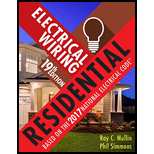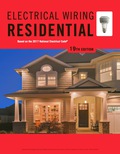
Electrical Wiring Residential
19th Edition
ISBN: 9781337101837
Author: Ray C. Mullin, Phil Simmons
Publisher: Cengage Learning
expand_more
expand_more
format_list_bulleted
Question
Chapter 4, Problem 15R
To determine
List the differences between Type AC and Type ACT armored cables.
Expert Solution & Answer
Trending nowThis is a popular solution!

Students have asked these similar questions
2. For the OPAMP below:
g) Grounding the inputs, perform a DC analysis (assume beta is infinite and VBE=0.7V and neglect the early voltage),calculate the DC currents and voltages everywhere in the circuit (all the collector and emitter currents and voltages aswell as the output voltage). Note that Q4 is 4 times as big as Q9 and Q3h) If Q1 and Q2 have a beta of 100, calculate the input bias current to the opampi) What is the input common mode range of this opamp?j) Calculate the common mode gain if the early voltage of Q3 and Q6 is 50Vk) Calculate the differential gain vo/vid of this circuitI) Calculate the input and output impedance of the opamp assuming beta is 100m) Calculate the input referred offset (Vos) if R2=21K
1. For the difference amplifier below, R1=R3=10K, R2=R4=50k, assume opamp is ideala) Find the differential mode gain, Admb) Find the input impedance (differential, between wi and va)c) Find the common mode gain in the presence of resistor mismatch (If R3=R1+ deltaR1, R4=R2+ deltaR2, deltaR1=100, deltaR2=500)d) Find the common mode rejection ratio (CMRR)e) Find the input impedance and output impedancef) If the OPAMP has an input current of 100uA, find the output offset voltage, set Vi1 = Vi2=0V
For the circuit shown, I-20 mA, R₁ =10000 2, R2 =2000 Q, R3 -2000 Q, R₁-6000 2, Vcc 5 V and the
OPAMP is ideal with regions of operation are considered.
The output current lo in mA is (choose the closet value):
R₂
Is
R₁
W
VCC
-VCC
The relative tolerance for this problem is 1 %.
-0.458
-0.833
6.667
-6.667
○ 0.458
0.833
w
R3
w
RL
Chapter 4 Solutions
Electrical Wiring Residential
Ch. 4 - The largest size solid conductor generally...Ch. 4 - What is the minimum branch-circuit wire size that...Ch. 4 - What exceptions, if any, are there to the answer...Ch. 4 - What determines the ampacity of a wire?Ch. 4 - What unit of measurement is used for the diameter...Ch. 4 - What unit of measurement is used for the...Ch. 4 - What is the voltage rating of the conductors in...Ch. 4 - Indicate the allowable ampacity of the following...Ch. 4 - Prob. 9RCh. 4 - What are the colors of the conductors in...
Ch. 4 - For nonmetallic-sheathed cable, may the...Ch. 4 - Prob. 12RCh. 4 - Under what condition may nonmetallic-sheathed...Ch. 4 - a. What is the maximum distance permitted between...Ch. 4 - Prob. 15RCh. 4 - Prob. 16RCh. 4 - Prob. 17RCh. 4 - Prob. 18RCh. 4 - Prob. 19RCh. 4 - Circle the correct answer to the following...Ch. 4 - When running Type NM cable through a bored hole in...Ch. 4 - Where is the main service-entrance panel located...Ch. 4 - Is it permitted to use flexible metal conduit over...Ch. 4 - Liquidtight flexible metal conduit may serve as a...Ch. 4 - It is permissible for an electrician to connect...Ch. 4 - Terminals of switches and receptacles marked...Ch. 4 - Wire connectors marked AL/CU are suitable for use...Ch. 4 - A wire connector bearing no marking or reference...Ch. 4 - When Type NM cable is run through a floor, it must...Ch. 4 - When nonmetallic-sheathed cables are bunched or...Ch. 4 - In diagrams A and B, nonmetallic-sheathed cable is...Ch. 4 - The marking on the outer jacket of a...Ch. 4 - A 120-volt branch circuit supplies a resistive...Ch. 4 - In problem 35, it is desired to keep the voltage...Ch. 4 - Prob. 37RCh. 4 - The allowable ampacity of a 4 AWG THHN from Table...Ch. 4 - If, because of some obstruction in a wall space,...Ch. 4 - The recessed fluorescent luminaires installed in...Ch. 4 - Prob. 41RCh. 4 - What size overcurrent device protects the...Ch. 4 - May the 20-ampere small-appliance branch circuits...Ch. 4 - A 30-ampere branch circuit is installed for an...Ch. 4 - In many areas, metal framing members are being...Ch. 4 - Are set screwtype connectors permitted to be used...Ch. 4 - Most armored cable today has 90C conductors. What...Ch. 4 - If you saw two different types of SE cables, how...Ch. 4 - Circle the correct answer defining the type of...
Knowledge Booster
Similar questions
- For the circuit shown, let R₁-4, R2-50, R3-2, R4-77 and Vin-18. Find the current I₁ and voltage Vo as follows: Use op-amp building blocks to determine the voltage Vo1: V01 = Then use Vo1 to find the current 11: 1₁ = Find the voltage Vo: Vo= R1 www Vin R₂ ww V01 R3 The relative tolerance for this problem is 9 %. + R4 www +5°arrow_forwardFor the circuit shown, let Vs1 = 13, Vs2 = 7 R1-10, R2= 50, assume ideal-op-amp, and find • The current Is • The output voltage Vo= VSI A S R₁ ww 1 R₂ www V₁₂ + Varrow_forwardFor the circuit shown, let R₁ =16 Q, R₂ =48 2, R3 = 28 2, R4 =84 02, R5 -2002, R6 -80 2, and V₁ =4 mV. Assume ideal op-amp, find (round your answer to three digits) : Va= (MV) Vb = (MV) (mA) Vout = (MV) R₁ R₂ V₁ + R3 Vb W The relative tolerance for this problem is 7 %. ww R4 24 R5 55 R6 VOUTarrow_forward
- For the circuit shown, find the voltage Vo and current l。. Let R₁=8, R2=1, R3-11 and V₂-3. V S (+1 || w R₂ R1 + R3 Vo The voltage Vo is: The current lo is: The relative tolerance for this problem is 3 %.arrow_forwardFor the circuit shown, find currents 11, 12, 13, and the voltage Vo. Assume ideal op-amp, and let R₁=3, R2-40, Ro=85 and 1-6 The current I₁ is: The current 12 is: The current 13 is: The voltage Vo is: R₂ w R₁ 13 w Roarrow_forwardFor the circuit shown, let v₂ = 9, R₁=86, R2= 15, R3 =7, assume ideal-op-amp, and find • The current l₂ = • Voltage gain, Av= Vo/Vs= • The output voltage vo = A US 1+ 1. R₁ R₂ R3 10 +arrow_forward
- For the op-amp circuit shown, find the voltage Vo, and the current lo. Let R₁=8, R2=58, R3-27 and V₂-101. R1 + R₂ ww + V + The voltage Vo The current lo = = The relative tolerance for this problem is 3 % R3arrow_forwardThe circuit shown in Fig. 14.98 has the impedance Z(s) = 1,000(s+1) (s+1+j50)(s+1 – j50) ' s=j@ Find: (a) the values of R, L, C, and G (b) the element values that will raise the resonant frequency by a factor of 103 by frequency scaling Z(s) Figure 14.98 For Prob. 14.81. R 7arrow_forwardChapter 14, Problem 57. Determine the center frequency and bandwidth of the bandpass filters in Fig. 14.88. 1 F ΙΩ ww V. (+ 1 F 10 V 1 H m (a) (b) ΙΩ ww ΙΩ 1HV Figure 14.88 For Prob. 14.57.arrow_forward
- Chapter 14, Problem 43. Calculate the resonant frequency of each of the circuits in Fig. 14.82. C (a) Figure 14.82 For Prob. 14.43. (b) C Larrow_forwardChapter 14, Problem 69. end Design the filter in Fig. 14.94 to meet the following requirements: (a) It must attenuate a signal at 2 kHz by 3 dB compared with its value at 10 MHz. (b) It must provide a steady-state output of v。 (t) input v, (t)=4sin(2 × 108t) V. = 10 sin(2x 108t+ 180°) V for an Rf ww R ww C 1+ Vs Figure 14.94 For Prob. 14.69.arrow_forwardChapter 14, Problem 15. Construct the Bode magnitude and phase plots for 40(s+1) H(s) (s + 2)(s+10) s=j@arrow_forward
arrow_back_ios
SEE MORE QUESTIONS
arrow_forward_ios
Recommended textbooks for you
 EBK ELECTRICAL WIRING RESIDENTIALElectrical EngineeringISBN:9781337516549Author:SimmonsPublisher:CENGAGE LEARNING - CONSIGNMENT
EBK ELECTRICAL WIRING RESIDENTIALElectrical EngineeringISBN:9781337516549Author:SimmonsPublisher:CENGAGE LEARNING - CONSIGNMENT

EBK ELECTRICAL WIRING RESIDENTIAL
Electrical Engineering
ISBN:9781337516549
Author:Simmons
Publisher:CENGAGE LEARNING - CONSIGNMENT